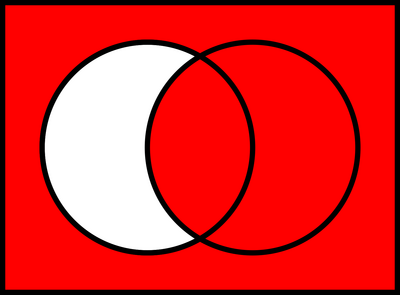
and since humans hv the ability to do hypocrisy (aka value-action gap, rationalisation, memetic-immune-system), it enables our verbal values to evolve independently of what makes effective behaviour. this is crucial, and (i think) extremely lucky, bc no brain cud possibly evolve cosmopolitan values if it had to actually implement it in its behaviour.
whenever i think of "evidence" (aka likelihood-ratio) or "implication", i first imagine a filled-out possibility-space. now, if "A implies/evidentiates B", then the possibility-juice in A squishes into the A∩B-region. visualize the squishification!
iow, if A is evidence, then "P(B|A)>P(B|U)", where "U" is the universal set.
iow, if A is evidence, then B is more likely when u *know* u are anywhere in region A, compared to how likely B is when u are anywhere in U.
imo the hack to grokking Bayes is to focus on the likelihood-ratio. that's the only initially-counter-intuitive part.
and the likelihood-ratio is exactly the quantified version of material implication.
one of my favourite visualizations of an idea-ecosystem. i shud stare at it more often.
i wonder how it looks if u let producers charge individual prices based on perfect information abt what consumers wud be willing to pay (ie "price-gouging" on a per-consumer basis)? does the system learn faster? do consumers lose? what if all welfare-havers are both consumers and producers?
(btw this meme is v memetically unfit bc its not factoring out its topics. to survive in the memetic economy, u hv to "niche-segment" ur outputs. now talking abt i can hold my breath for 4 mins straight is an example of the opposite of niche-segmentation. niche-segmentation is unintuitive but much-much important pattern evywhere, so i rec grokking it!)
I actually think the brain uses both.
I think it's usually model B. I think effortfwl recall correlates w alpha oscillations bombarded across the cortex, and this reduces temperature in non-bombarded areas. Successfwl recall correlates w P300 EEG-signature, which according to Dehaene indicates a preponderance of inhibitory neurons.
But I also think I've had personal success w "deconcentration of concentration" to recall blocked Tip-of-the-Tongue memories. And this corresponds to model A!
B) FREE UP ENERGY FOR ORDER
Assume that the height of the threshold depends on the stability of sub-completions of m, because the pattern can't complete if its progress gets partially reset all the time.
Now, you can make it easier to recall m by lowering neighborhood noise. But if there are competing memories in that same neighborhood, you may end up accidentally stabilizing the wrong one.
A) STOCHASTIC RESONANCE
Assume that the transition to m depends on a threshold for total activation of m *relative to* competitive activity nearby.
Now, to recall m, simply add uniform noise to the general neighborhood of M. The noise is merely additive for neurons not in M, whereas it's *multiplicative* for M due to its loops. The noise relatively amplifies activity in recurrent networks, but only if they survive the noise (ie exceed the "error threshold" for mutation).
Assume memory m is an ordered state in recurrent cell assembly M.
M is usually in any of its many disordered states due to stochastic activity in its neighbourhood, but there's always a threshold for *pattern-similarity* to m (wrt phase/frequency of constituent neurons) above which its internal feedback loops suffice to autocomplete the rest of it.
Here are ways you can lower that threshold and likelify M's phase-transition into m →
How would you (in theory) manually store memories into a ferromagnetic material (cf Ising model)?
By "disguising" the memory-pattern with the energy signature of the naturally ordered state (eg uniform), from the perspective of the magnetic field.
"Recalling" the memory means lowering local temperature to the (critical) Curie point.
The "associative memories" to a ferromagnet X is anything that is *paramagnetic relative to* X.
Generalize to get Hopfield networks.
a nice thing abt feeling free continually develop my own idiolect wo anyone's permission, is that i can write my morning thoughts in 11 paragraphs instead of a big hecking book
i have no expectation that anyone can read and understand evything i'm saying here, but can think of it like "here's a demonstration of how u can write notes to urself; feel free to emulate to see if it works for u"
also, there are several logic-leaps here w lots of missing pieces even in my head, so read w salt
This incidentally is also why a high level of interpretative charity is so important for cultivating good intentions in a community. Whenever you socially reward/punish weak proxies for good/bad intentions, you invite Goodhart into the reward function.
The simplest case for why voluntary lie-detection technology ("Cognitive Veracity Meters") is essential for the longterm morality of earth-originating life is this:
A) Most of our prosocial motivation develops as a consequence of being rewarded for making other people like us. (Indirect reciprocity.)
B) That incentive cannot reach the deepest parts of our decision-making algorithm, unless our intentions are transparent / cheaply verifiable.
C) CGM makes our intentions cheaply verifiable.
Nvm, it doesn't make sense to base anything on "the utility of being where you're at" or "your current stock of utility". Utility is a relative measure of choice-worthiness / preference between options.
In reality, what you should be measuring is the utility of *being in the state* where you've won or lost. The trick is to somehow estimate that based on the measured size of the bet and the experienced utility of being where you're at.
How does the brain do it? And where does it go wrong?
Flowers are selective about what kind of pollinator they attract. Diurnal flowers use diverse colours to stand out in a competition for visual salience against their neighbours. But flowers with nocturnal anthesis are generally white, as they aim only to outshine the night.





